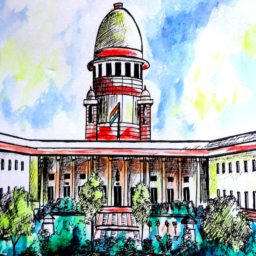INTRODUCTION
A co-operative society is a sovereign voluntary association of people who have everyday needs. The 97th Constitutional amendment Act of 2011 gave Co-operative societies the recognition as a fundamental right under Article 19 of the Indian Constitution. This amendment introduced a new directive principle of state policy on promoting the co-operative society under Article 43(B) and added a new part forming IX-B in the Constitution of India from article 243-ZH to 243- ZT. The objective of a co-operative society is to grant support and help its members.
HOW IS IT FORMED?
Co-operative societies were first incorporated under the provisions of the Co-operative Societies Act, 1912. At least ten people above 18 can enter into a contract with common economic objectives like weaving, dairy business, consuming, farming, etc. Though the co-operative societies are a state subject under Entry 32 of List II of the Seventh Schedule of the Constitution, the Co-operative Societies Act is a Central Legislation.
A simple example would be a man residing in a village selling milk. Every day he is left with a surplus of 5 liters of milk. There is no one in the town to buy that milk. He goes to the city to sell it, but he doesn’t have enough resources for accommodation. One day, a learned man in the village told the man that he isn’t the only one to face this issue. He suggested bringing all of those people together who are facing the same problem. In the morning, collect all the surplus milk and send one person to the city to sell the milk. In the evening, they sit together and distribute the earnings per day equally amongst themselves. The men executed this technique, and gradually the accommodation problem was solved, and the flow of income became steady. This formation of a group can be called mutual help. Eventually, besides selling just milk, they started to produce milk products like ghee, butter, cheese, and other dairy items. Seeming to be an achievable task, they started making quality milk products collectively and exported them to the nearby towns and gradually across the state. The profit gained and success was possible only because of their joint efforts and co-operation.
EVOLUTION OF CO-OPERATIVE SOCIETIES IN INDIA
The term ‘co-operatives’ was added after “unions and associations” in Article 19(1)(c)[1] under Part III of the Constitution. These provisions provide the citizens with the fundamental right to form co-operatives. In part IV of the Constitution, under the Directive Principles of State Policy. The Co-operative societies of today have direct nexus with the 19th Century’s Co-operative movement.
The Industrial Revolution had nearly shut down the village industries and drove the villagers towards agriculture, the last resort for livelihood. In Madras, the co-operation of Mutual-Loan Associations was formed. In Punjab, co-operatives for controlling the common lands in the village were formed. These efforts by the citizens were wholly voluntary and non-official.In 1915, Sir Edward Maclagan formed the Maclagan Committee. The committee was appointed to study and report whether the co-operative movements functioning across the country were economically stable and financially sound.
In 1919, the co-operation during the Montague Chelmsford Reforms became a provincial subject that boosted the movement’s success. Individual states did their acts to promote trade, mutual co-operation, etc. The numbers of co-operative societies and their respective numbers increased rapidly.
After Independence, co-operative societies continued to function, and were considered balancing factors between public and private sectors. Post- Independence, co-operatives became an integral part of the following five-year program under the tenure of Pandit Nehru as Prime Minister. The National Co-operative Development Corporation (NCDC) was formed as a statutory corporation under the National Cooperative Development Act, 1962. Therefore, we can see that co-operative is not a new term. It is embedded in our Indian Constitution and society for a very long time.
HOW IS A CO-OPERATIVE SOCIETY FORMED?
The Co-operative society is mentioned under the state list of the seventh schedule and is mentioned under Part IX-B of the Constitution of India. Co-operative societies as a subject matter wholly belong to the state legislatures exclusively.
Since the Co-operative society is enlisted under the State List, the State Legislature has the powers to make provisions for the incorporation, regulation, and winding up of any co-operative society based on the principles of autonomous functioning and voluntary formation of the members’ other related factors. The state legislature sets the number of directors to be there on the board of a co-operative society. The state legislature shall also give directors to reserve one seat for the Scheduled Castes or Scheduled Tribes & two seats for women in every co-operative society. The board’s elected members shall be in office for five years since the date of the election[2].
Election for the new board members shall be conducted before the expiry of the term of the previous board. The new members should immediately occupy the office after the expiration of the period of the last panel. The process of conducting elections, superintendence, and direction shall vest within the co-operative society as laid down in the regulations by the State Legislature. The state legislature has all rights to impose penalties over any particular co-operative society for violating the rules. [3]
TYPES OF CO-OPERATIVE SOCIETY
- Consumer’s Co-operative Society: These societies safeguard the interests of general consumers by manufacturing and selling goods at a reasonable price.
- Producers’ Co-operative Society: These societies protect the interest of small producers by making the resources like raw materials, tools, equipment, and other things readily available to the producers.
- Co-operative Credit Society: These societies provide monetary support to their members. These societies grant loans at reasonable rates of interest in times of need.
- Farming Co-operative Society: These societies provide small farmers to work jointly in large-scale farming.[4]
DISPUTES RELATED TO CO-OPERATIVE SOCIETIES
In Rambujrat Ramraj Chaurasia vs. the State of Maharashtra[5], it was observed that Co-operative Societies are part of the constitutional scheme. Co-operative societies are Part of the Constitution enshrined under part IX-B. A dual bench of Justice Ujjal Bhuyan and Justice Abhay Ahuja heard the issue and observed that Co-operative Societies are Part of the constitutional scheme and that they are a part of the Constitution enshrined under part IX-B. Co-operative societies should have the necessary space, power, and autonomy to function independently and develop their full potential. Unless there arises a severe statutory breach, the co-operative societies should not be interfered with
Recently on 21st July 2021, in the case of Union of India vs. Rajendra N Shah[6], the Supreme Court struck down most of the provisions of the 97th Constitutional Amendment.
The Background of this case is that in 2011, this amendment was first challenged in Gujrat, High Court. The HC held that the amendment to the extent it introduced conditions for state laws on co-operative societies, was liable to be struck down as it was passed without ratification of one-half of the state legislature, as mandated by the procedure laid down in Article 368(2), i.e., if the parliament wants to make any changes in the seventh schedule of the Constitution, it has to take ratification from the state legislature first, for making changes to an entry in the state list (LIST II). The HC ruled that the co-operative societies are state subjects as per entry 32 of List II of the Seventh Schedule. The amendment introducing part IX-B required ratification, which it didn’t. Introducing this part, IX-B was to transfer all powers from the state legislature to the Central Government. Therefore, the Gujrat HC struck down the provisions of part IX-B introduced by the 97th Constitutional Amendment, 2011, to the extent they were related to co-operative societies. [7]
This Amendment was later challenged in the Supreme Court in 2013. In 2021, the 3 -judge bench comprising of Justices Rohinton Nariman, KM Joseph, and BR Gavai observed that the requisite ratification from states was not obtained according to article 368(2) of the Constitution while bringing in the 97thamendment since it dealt with an entry which was an exclusive state subject (co-operative societies). It was unanimously observed that the state legislature did not obtain the ratification and was liable to be struck down. Supreme Court observed that the amendment impacted the executive-legislative power of the state legislatures. [8]
Ex- Justice Rohinton Nariman and Justice Gavai upheld those provisions of part IX-B which dealt with multi-state co-operate societies by applying the Doctrine of Severability. The SC upheld the judgment of the Gujrat HC except to the extent that it strikes down the entirety of Part IXB of the Constitution of India. Only those parts of IX-B which were invalid on the grounds of procedural ambiguity raised under article 368(2) will be struck down. One dissenting opinion was that to struck down the whole part IX-B, but the majority sustained.
The SC upheld the validity of the provisions of Multistate Cooperative Societies. MSCS is not confined to one state. It is declared that part IX-B of the Constitution is operative only in so far concerns the multi-state cooperative societies both within the various states and in the union territories.
CONCLUSION
Co-operative societies are easy to form democratic management groups. Safeguarded by the Constitution, it allows people to help each other and benefit from it mutually. Therefore, being a particular business organization has many benefits, and it should be exercised when required as it is a fundamental right granted to the citizens.
Author(s) Name: Avik Ghose (Xavier Law School, Xavier Institute of Management University, Bhubaneshwar)
References:
[1] The Constitution of India, art 19.
[2]M Laxmikanth, Indian Polity, 5th Edition, Pg. 60.3.
[3]M Laxmikanth, Indian Polity, 5th Edition, Pg. 60.4
[4] Ministry of Statistics and Programme Implementation, <http://mospi.nic.in/sites/default/files/Statistical_year_book_india_chapters/CO-OPERATIVE%20SOCIETIES-WRITEUP.pdf> accessed 23 August 2021.
[5]Rambujrat Ramraj Chaurasia vs. the State of Maharashtra, WP-ASDB-LD-VC. 220 OF 2020
[6]Union of India vs. Rajendra N Shah, 2021 SCC Online SC 474
[7]Tejaswi Pandit, “Part IX-B of Constitution relating to cooperative societies unconstitutional for want of ratification by half of the States; Provisions relating to multi-State cooperative societies severable and valid”, 21st July 2021,SCC Online, <https://www.scconline.com/blog/post/2021/07/21/constitution-97th-amendment-act-2011/> accessed 2 September 2021.
[8]Manu Sebastian, “Supreme Court Strikes Down 97th Constitutional Amendment To The Extent It Relates To Co-operative Societies”, 20th July 2021 , Live Law Network, <https://www.livelaw.in/top-stories/supreme-court-strikes-down-97th-constitutional-amendment-to-the-extent-it-relates-to-cooperative-societies-177789> accessed 23 August 2021.
















